Higher education has two primary purposes: (1) student learning for the improvement of self, family, employers, and society at large, and (2) knowledge generation, conservation, and dissemination for the advancement of everyone, now and in the future. To succeed in meeting these goals over the long term, colleges and universities
- have to be effective and efficient (the economic perspective);
- should respond and adapt to the wants and needs of various stakeholders (the cultural perspective);
- must serve the greater good of the community (the social or civic perspective); and
- must demonstrate good judgment and leadership (the political perspective).
We believe the role of the chief information officer (CIO) is to contribute to these strategies through the investigation and use of technological systems. A technology system is defined as a human-made, intelligence-based resource that has four interrelated components: tools, skills, information, and processes.1 All four components of an operational technology system interact dynamically and are required simultaneously for an organization’s successful performance.2 Since technological innovation underpins the competitive status of modern organizations, making sound decisions about which technologies to recommend and how to justify these recommendations to presidents, provosts, and governing boards is one of the chief responsibilities of CIOs in academic institutions. It is a significant and challenging part of the job, and some presidents have noted that they do not always understand the proposals that CIOs put forward.
In a recent article in EDUCAUSE Review, for example, John Cavanaugh, president of the University of West Florida, noted that many senior academic administrators still seem reluctant to invest in information technology. He suggested that CIOs reframe the issue and, instead of presenting their proposals for “tangible stuff,” focus on “tangible use.” He wrote, “We need to reframe the IT issue to emphasize what people do with the tangible stuff, thereby focusing the issue on knowledge creation and knowledge management. This view is 180 degrees from the ‘tangible stuff’ view.”3
Cavanaugh’s proposal to use a rationale for IT investments that makes sense to presidents and other senior administrators seems a sensible one. As a university president, he clearly has a high-level perspective on what arguments are most compelling for college and university executives.
A review of the literature suggests that CIOs also seek the most strategic justification (the “one right argument”) to gain support for their IT proposals because senior executives might be reluctant to make significant investments in new IT initiatives. However, relatively little is known about the thought processes that CIOs follow to make decisions about technological initiatives because the CIO role at colleges and universities is relatively new and because there has been little research on this topic. Obviously, then, through inquiry into this issue we are better positioned to construct a best-practices framework for college and university CIOs that they can use to shrink the resource gap by making the best proposals possible and by presenting them in ways that enlist other senior academic leaders as allies and supporters.
This article describes a study designed to understand the decision-making mindset of CIOs at colleges and universities. The ultimate goal was to develop more systematic processes for technology decision making that integrate the best and most relevant perspectives. The conceptual framework for information technology decision making by CIOs presented here was initially constructed through a comprehensive analysis and synthesis of the literature of higher education administration and technology management.4 The framework was then compared, through a survey of CIOs, to real-world practices at liberal arts colleges and universities.
Conceptual Framework
To find out more about the mindset of CIOs relative to their decision-making and justification processes, we surveyed CIOs representing the membership of the Consortium of Liberal Arts Colleges (CLAC).5 The survey’s primary purpose was to ascertain if CIOs at liberal arts institutions have a mindset that encompasses all four strategy perspectives (economic, social, cultural, and political) when they consider major technology innovations. (See the sidebar for more on multiple perspectives.) Figure 1 shows the relationship of multiple perspectives by higher education CIOs in decisions involving strategic technological innovation. The figure represents each strategy perspective as part of an integrated schematic framework. Essential components of the framework include processes, key participants, strategies, and goals identified with each perspective. The multiple-perspective framework is potentially useful in developing a common collaborative language to boost CIO communication with presidents, other key decision makers, and stakeholders.
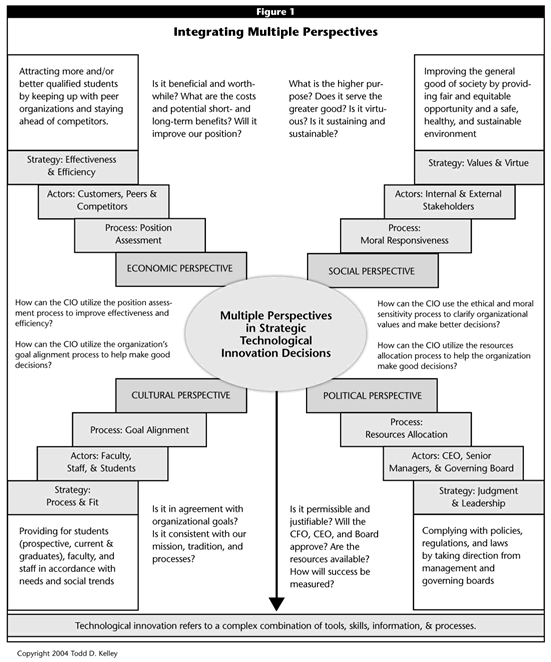
Click image for larger view.
The framework can serve as a guide for the systematic investigation of various perspectives for technology decision making by college and university CIOs. It is not intended to be prescriptive or restrictive; it aims to support critical thinking and actionable intelligence. The framework can be used to
- identify the perspective(s) that individuals and organizations take in their approach to technology decision making, and
- make sure that all perspectives have been considered when comparing assessment data for planning and decision making.
It seems axiomatic that multiple perspectives are beneficial in complex organizations. Many managers may indeed function from a list of implicit perspectives. The test of a profession, however, is its ability to come together as a community of practice to make the implicit become explicit and to test and build upon shared knowledge to advance the profession’s purpose and practices. Using a multiple-perspective framework to consider technology system decisions at colleges and universities benefits CIOs and their institutions because without such an approach to decision making, both CIOs and their institutions are susceptible to lurching from one decision to the next, based on the most popular perspective of the time. A multiple-perspectives framework provides a roadmap for decision making that can transcend trends and fads and that can be read and understood by all participants. Thus, the framework provides a helpful heuristic for CIOs and other higher education decision makers.
Economic Perspective
The economic perspective can be summarized with the following points:
- Goal: attract more and/or better-qualified students by keeping up with peer organizations and staying ahead of competitors
- Strategy: effectiveness and efficiency
- Dominant process factor: position assessment
- Entities to consider: competitors, peers, customers
- Overarching question: In making technological decisions, how can the CIO use the position-assessment process to have a positive impact on organizational effectiveness and efficiency?
The issues that figure prominently in literature highlighting the economic perspective are competitor, peer, and customer comparisons. As we might expect, the traditional language of business dominates publications representing the economic perspective. Exemplary articles for the economic perspective include “Seven Benchmarks for Information Technology Investments,” by Smallen and Leach,6 and “A University Is Not a Business (and Other Fantasies),” by Greenberg.7 During the past 10 years, the economic perspective has dominated the literature we reviewed.
Cultural Perspective
The cultural perspective can be summarized with the following points:
- Goal: provide support for students, faculty, and staff in accordance with educational needs, social trends, and norms
- Strategy: process and fit
- Dominant process factor: goal alignment
- Entities to consider: faculty, staff, and students (qualified prospects, current students, and alumni)
- Overarching question: How can the CIO use the process of goal alignment to help make decisions that provide for the educational needs of faculty, staff, and students?
Goal alignment is the tacit organizational process underlying consideration of organizational culture in higher education. Process and fit issues dominate the general higher education management literature that we reviewed.8 Historically, the participants most discussed in this literature are faculty, followed by administrative staff and governing boards. Historically, students have been discussed only marginally in the literature reflecting a cultural perspective, and the addition of students in this body of literature appears to be a relatively recent development. Technology management literature focused more on campus culture and technology integration issues during the 1980s and early 1990s than it has in recent years.
Social (Civic) Perspective
The social, or civic, perspective can be summarized with the following points:
- Goal: improve society by adhering to laws, providing equitable opportunity, and creating safe, healthy, and sustainable communities (for example, the community beyond campus walls)
- Strategy: values and virtue
- Dominant process factor: moral responsiveness
- Entities to consider: all stakeholders (students, employees, employers, and the general public)
- Overarching question: How can the CIO use the process of moral responsiveness to help make decisions that will improve society in general, as well as the organization’s stakeholders and the communities beyond the campus walls?
The trend in higher education has been toward competitive strategy, and social factors have increasingly taken a back seat to economic ones. Some portion of the social perspective literature represents a backlash against the increasing dominance of the economic perspective; for example, see the article “Cyberprof: The University in the Next Millennium,” by Bothun.9 A more proactive reflection of the social perspective is apparent in the information literacy and fluency movement (see, for example, “Information Literacy as a Liberal Art,” by Shapiro and Hughes10). Some might suggest that the social and economic perspectives are mutually exclusive—and that they should be—but this reflects a misunderstanding of business and of higher education, which have multiple purposes11 that overlap and are thus not mutually exclusive.
Political Perspective
The political perspective can be summarized with the following points:
- Goal: satisfy the president, senior managers, and board by influencing, anticipating, and addressing their priorities
- Strategy: judgment and leadership
- Dominant process factor: resource allocation
- Entities to consider: board, president, and senior managers
- Overarching question: How can the CIO utilize the resource-allocation process to anticipate and meet the goals of the president, senior managers, and board?
Organizational politics affect which managers and departments get attention and resources and which do not.12 The president and board may be focused on fiscal or other matters and have little time for technology issues. Most presidents understand at some level that technology is important, but few of them have the time or inclination to delve deeply into specifics. The president may view the CIO as “the technical expert”—the right person to formulate technical proposals. To succeed, however, the CIO must speak a language that the CEO and board members understand.
A primary political “task” for the CIO is to develop an intersection of interest with the president and board that strengthens individual leadership and organizational success. Effective politics means working successfully with presidents as the ultimate managers in charge, with overall responsibility for their organizations. The effective CIO is adept at bringing technology needs and proposals before the president in such a way that decisions are informed and thoughtful, lead to enhanced IT capability, and make the organization stronger and more successful.
Surveying the CIO Mindset
We administered a questionnaire in fall 2004 to 58 CIOs from CLAC member institutions. Questions included
- whether or not they regularly consider the perspectives identified in the framework;
- if they use multiple perspectives as a matter of course in their decision making;
- if they have perspectives or practices that fall outside the perspectives, strategies, and processes identified from the literature;
- what weight they would give to each of the identified perspectives;
- what type of data and to what extent they use data as a basis for their recommendations; and
- the ease or difficulty they have in getting their proposals accepted and funded.
Fifty-four (93 percent) of the 58 CLAC CIOs responded to the survey, with 48 (83 percent) completing the entire questionnaire.
Key Features of the Survey
The survey design used multiple methods of asking the CIOs about their thinking and activities relative to making proposals:
- Partially closed questions: respondents could select one or more answers or provide their own answer.
- Open questions: respondents were asked to explain the methods or rationale used for technology decision making on their campuses.
- Scenarios: respondents were asked to describe an initiative or project that illustrated their methodology.
- Scaled responses: respondents were asked to assign a value to rationales and justifications based on their own experience. Or, they could add to the list and assign a value to their own rationale or justification.
A copy of the survey instrument is posted on the Web at <http://www.surveymonkey.com/Report.asp?U=80115517708>.
Overview of Findings
Major findings of the survey include the following:
- Most respondents believe that providing a strong rationale to presidents, senior executives, and governing boards is very important. On a scale of 1 to 5, with a score of 5 representing very important, the mean score for 54 respondents was 4.52.
- As expected, all four perspectives identified in the literature review are used by all 48 CIOs who completed the entire questionnaire. But while one or more of the four perspectives seemed meaningful to all the CIOs, using all four perspectives only made sense to a limited number of CIOs.
- After comparing and normalizing the weight of scaled responses using the Saaty pair-wise comparison methodology,13 the scores demonstrate that the political and economic perspectives are weighted heavily by these CIOs as a group, the cultural perspective is somewhat less important, and the social perspective is given relatively little weight.
- While many of the CIOs surveyed appear to be highly successful in formulating and getting approval for major initiatives, clearly some (almost 25 percent) are not as successful. The basis for organizational success with technology over the long term is not as clear for all CIOs because of two factors identified by the survey.
- First, the tools and processes for assessing the current environment and for technological planning are limited primarily to cost data and comparative data among institutions. It appears that only a small percentage of CIOs formally collect or use data about the need for and use of technology on their campuses.
- Second, there is also a high positive correlation between CIOs who report directly to the president and success in getting proposals formulated and funded. CIOs who report to a dean or vice president have a much higher probability of frustration in their efforts to get proposals accepted and funded.
Analysis of Findings
We wanted to confirm that CIOs feel that the decision-making and justification process is important for their success. We also wanted to determine the importance of rationales in the process, so we asked respondents about the importance of presenting a rationale for decisions to presidents or other key executives or governing groups. The results indicate that 48 (89 percent) of the 54 respondents believe that a rationale is very important (63 percent) or important (26 percent), and 6 (11 percent) believe that it is somewhat important. No respondent believes that this activity is of little or no importance. A representation of these findings appears in Figure 2.
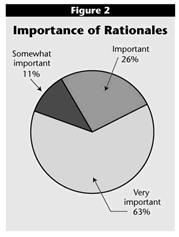
Click image for larger view.
Respondents were also asked to define a major initiative in terms of the overall cost (any cost, either direct or indirect, associated with the initiative). The results of this question were surprising, as there appears to be little agreement as to what constitutes a major initiative in terms of cost. This finding might be explained by the significant differences among the budgets of the institutions represented in the survey. The annual institutional budgets range from $29 million to $149 million. However, we found little correlation between institutional budget and the threshold the CIOs use to define a major initiative.
Classification of Rationale Strategies. One technique used in the questionnaire was to ask CIOs about the perspectives that represent the rationales they use. When asked to classify the rationales used for proposals, 89 percent of respondents selected one or more of the four perspectives provided. Seventeen percent selected all four perspectives. See Figure 3. Note that numbers in the figure are rounded.
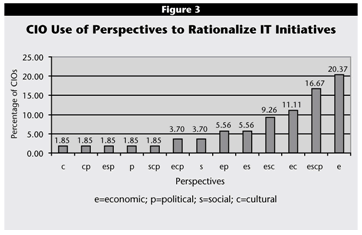
Click image for larger view.
Use of Rationale Strategies. Another technique used in the questionnaire was to ask the CIOs about the specific rationale strategies employed when formulating or presenting proposals. A list of rationale strategies was provided to respondents, and they were asked to add their own strategies to the list. The strategies provided in the survey are listed here:
- Keeping up with peer organizations
- Staying abreast of competitor schools
- Attracting better/more students
- Improving the general good of society
- Providing fair and equitable opportunities
- Providing a safe and healthy environment
- Promoting sustainability
- Providing for the needs of faculty
- Providing for the needs of staff
- Providing for the needs of students (prospects, current students, and graduates)
- Honoring organizational mission, traditions, and processes
- Adapting to social trends
- Taking direction from member(s) of senior management or governance body
- Enhancing efficiency (cost savings)
- Providing noticeable and/or measurable benefit(s)
- Complying with laws, regulations, or policies
- Supporting organizational mission
- Carrying out organizational goals or plans
Respondents were asked to rate the importance of each rationale strategy (including their own if they provided one) based on its usefulness in their careers as CIOs. Each of the rationale strategies provided is primarily associated with a particular rationale perspective (political, economic, cultural, or social), but these associations were not shared explicitly with the respondents. Scores for these answers were assigned to the appropriate perspective category, and category scores were compared and normalized using the Saaty’s pair-wise comparison methodology.14 Each perspective would be scored at .25 if respondents ranked all four perspectives equally, and all four scores must add up to 1.
Only two respondents gave scores of 0 to all the rationale strategies within a single rationale perspective category, so all four rationale categories received some positive response from 46 of 48 respondents. The composite (mean) scores appear in Table 1 along with the minimum and maximum scores for each perspective. Figure 4 shows the model balance of perspectives. Figure 5 shows the relative weight of the actual mean scores for each perspective compared to the model weight in Figure 4.
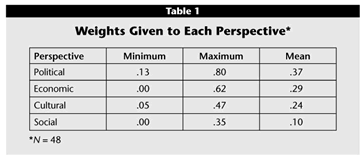
Click image for larger view.
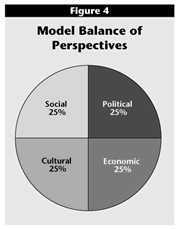
Click image for larger view.
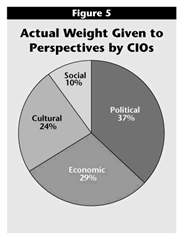
Click image for larger view.
Comparison of Perspective Categories to Rationale Strategies. The self-reported identification with the four perspectives shows that the majority of respondents consider their primary rationale to be the economic one, as seen in the literature review. When analyzing the actual rationale strategies that respondents selected, however, the political perspective dominated. While these two perspectives reversed in importance depending on the way the question was asked, the other two perspectives remained in the same relative positions for both methods. The change in position could be explained by the use of the term “political.” While overall, the CIOs gave high scores to rationale strategies that were political (in the most positive sense of the word), the term was not used in the rationale descriptions. However, the term was given as a choice in the self-categorization of perspectives. The term “political” may have negative connotations to some. Most significant in both measures, however, the political-economic axis of the framework dominates the cultural-social axis.
Decision Making Using Multiple Perspectives
The CIO role at colleges and universities is relatively new, and we believe the profession is still in the early stages of developing its mindset for decision making. Identifying and discussing the potential perspectives is helpful, but what CIOs and other campus leaders require over the long term are tools and processes for using these perspectives to consistently make the best decisions and to rationalize them in the most helpful manner.
When asked if they used data to support their proposals, many CIOs indicated that they did. Those that did generally gave examples from institutional data collection efforts by EDUCAUSE and CLAC, or financial (for example, pricing or cost savings) data for their initiatives. The cross-institutional data sources clearly constitute an advance for the profession, and they seem well suited for providing guidance and support for the economic perspective. Table 2 lists the CIOs’ reported use of supporting data for major initiatives.
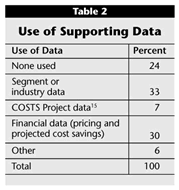
Click image for larger view.
At many liberal arts institutions, advisory groups made up of faculty, staff, and students have traditionally provided local information that CIOs need to make the best proposals and decisions. In the survey, 70 percent of CIOs reported that they have such a committee on their campuses, which might explain the paucity of formal data collection efforts. The committees may meet a need that more formal data collection practices would otherwise address. However, the use of segment and industry-level norms in the absence of formally gauging local needs could jeopardize the unique nature of each institution, resulting in many institutions beginning to look and act alike.16 CIOs need to create and adapt decision-making tools and processes that help them identify and articulate a shared vision with other campus leaders and constituencies and recognize and exploit emerging opportunities in a timely manner.
The findings from the CIO survey suggest that few CIOs regularly use the tools of social science to help determine the relative value constituent groups expect and actually experience. Decision tools that show promise in defining the needs and wants of subcultural groups include short online surveys and small focus groups. The regular use of surveys with prospective and current students, as well as alumni, can provide information about the expectations, current experiences, and long-term benefits of technology on campus.17 Using mixed focus groups of faculty, students, and staff can help members of each group understand the needs and perspectives of other constituencies as well as provide information that is valuable to the CIO in assessment, planning, and proposal formulation and rationale.
Based on the data from the CIO survey, many CIOs probably view social-science research as a luxury, or even an unnecessary expense, especially when they are under a great deal of time pressure. But the risk of proceeding without solid information about constituencies and their needs and priorities is too high and could put the CIO at odds with the president. The tools of social science can provide the counterweight the CIO requires.
Table 3 shows the relationship between the reporting relationship of the CIOs and the ease of obtaining support. It appears that, for this group of CIOs, the degree of difficulty in obtaining support depends upon the role of the supervisor. Reporting directly to the president uniformly predicts positive support for initiatives. Those reporting to provosts, deans, CFOs, or others have much more trouble obtaining positive support for initiatives.
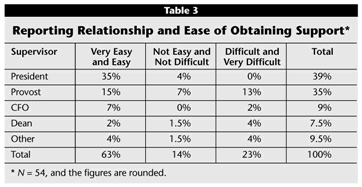
Click image for larger view.
Why do CIOs in this study who do not report to the president have a much higher probability of having a serious or very serious problem obtaining support than those who report to the president? Ultimately, the president decides where the CIO fits into the organization. Why do some presidents choose to have the CIO report to them and others have CIOs report elsewhere?
Significant tension can surround the proper role of the CIO because he or she might not be appropriately positioned in the organizational chain of command or may not have appropriate access for effective communications and leadership. President Carol A. Cartwright of Kent State University argued in 2002 that to make effective information technology decisions, the person in charge of technology needs to report to the president and must be a peer with other campus leaders.18
Presidents must decide how to position the CIO’s role within the organization so as to best facilitate the educational and communications objectives necessary to work collaboratively with the entire organization. At the same time, CIOs need to do their homework by stepping outside the technology role to understand the president’s priorities and to learn the culture(s) of institution. Presidents and other senior managers need to be broadly educated about technological systems—but not in the way that they might think. They need to understand the choices their organizations can make and the organizational processes they must develop to be both capable and competent when it comes to technology decisions.19 Capability is “know how” and competence is “know what.”
The organizational communications and workflow processes required are the foundation for any technology tools needed. Because CIOs must understand their presidents and their presidents’ priorities, presidents should question whether their CIOs can see, hear, and understand them based on where CIOs sit in the organization. Addressing this issue appears critically important for the overall success of the organization because of the important role that technology systems have assumed.
CIOs and presidents might not realize that their organizations need someone who can move beyond the management of technological tools, which, granted, is a difficult job in itself. The tools are just one part of the overall equation, however, and an unbalanced focus on them is counterproductive. The CIOs who will succeed have a complete understanding of the pressures their individual organizations and leaders face but can operate from an objective and fully informed appreciation for the unique mission and role of higher education in society—and have the data and information they need to back them up.
Discussion
While not surprised by the relative weight given each perspective, we are concerned that the total weight given to the social/cultural axis is overpowered by the total weight assigned to the economic/political axis. The primary purposes of higher education, as we stated earlier, do not seem adequately supported when it appears that CIOs have relatively less concern for the potential benefits that technology might bring to their constituencies and to society at large. It appears that the trend in higher education has been toward competitive strategy, and the cultural/civic perspective has increasingly taken a back seat to the political/economic one. There is no reason to believe that social and economic perspectives are or should be mutually exclusive. Technology is an extension of human physical and intellectual capacities, and as such it has grown far too powerful and central to our lives to be considered from only one or two viewpoints. A greater focus on the investigation of the relationship between people and technology, both on campus and beyond, seems warranted.
To the casual observer, the primary activities of CIOs in higher education might appear to be selecting the technology tools of the organization and keeping them working smoothly. However, the CIO role is already moving beyond this limited expectation, as it has become clear that colleges and universities require leadership in the development of organizational processes, knowledge capital, and human skill development relative to the technological tools that permeate institutions and society at large. The four components of technology that impact the effective implementation and use of technological systems require equal attention from the CIO in order to maximize the use and benefits of technology.
Multiple perspectives and rationale inventories give CIOs and their supervisors permission to withdraw from the technology tools “arms race” and to create a new professional space. The size and contours of this professional space are up to the practitioners. One disadvantage to having few if any formal educational requirements or standards for the higher education CIO is the absence of an interdisciplinary vocabulary that develops the ideas and values that guide us individually and collectively. It seems advisable to reconsider what knowledge and skills are necessary for a CIO’s success. One benefit of this study is to help clarify and expand the vocabulary of CIOs. With a clear and comprehensive vocabulary, CIOs can embrace the language of those who make important decisions.
Clearly, some CIOs focus almost exclusively on the technical aspects of their role and speak a technical language. This is a dialect that many administrators, constituents, and other stakeholders either do not understand or find insufficient to justify significant financial and human resource investments. Reliance on this language holds back some organizations, and, as a result, CIOs (and presidents) can become frustrated.
The larger purpose of this study was to help identify a new and clearer definition of the CIO’s role. Such a definition could be represented in the following description: The CIO works with the campus community (broadly defined) to:
- Develop a vision for the role of technology systems, consistent with organizational mission and objectives, constituent goals and needs, economic responsibility, and civic/societal concerns.
- Fulfill and bring that vision to life, through the effective stewardship of resources and thorough communication with all constituencies.
- Address questions and issues about the benefits, disadvantages, and issues surrounding technological systems in use and under consideration, as well as those in use elsewhere.
In this scenario, CIOs are conceived as having a broad organizational role and are not, for example, engaged in a struggle to convince their supervisors that particular technology systems are needed. Instead, through discussion, reciprocal influence, and collaborative learning, the CIO can influence campus stakeholders, and these agents can influence the CIO and president so that one vision results (subject to continuous revision, of course). This newly conceived CIO role has a critically important educational role in realizing the collaborative vision. This approach also reduces potential tension between CIOs and their supervisors because the CIO represents a collective vision rather than an individual one.
The CIO survey confirmed that the language and concepts of the multiple-perspective framework are understandable, relevant, and potentially helpful to individual CIOs and, collectively, to the development of the profession. Collectively, the CIOs used all perspectives. Based on the survey data, there is considerable variability in the number of perspectives used, and the regular use of all four perspectives appears to be the norm for a relatively small percentage of CIOs. Since this study was exploratory and necessarily limited, much can be done to question the framework, adjust it, and build on it. Use of the framework and inventory is needed in the field to investigate its efficacy in diverse settings.
Unfortunately, the findings from the CIO survey suggest that few CIOs regularly use the tools of social science to help determine the relative value that constituent groups expect and experience. A firmer understanding of prospective, current, and former students would create a stronger basis for promoting the cultural and social perspectives and would help provide a solid complement to the political and economic axis. In addition, establishing a “research partnership” with the faculty is extremely effective in gathering information in a way that is meaningful to an important subcultural group. It is also possible to “piggy-back” with other survey and research efforts to be efficient and to integrate the efforts of the CIO into other important functions of the organization. It is not just the data that are important; it is the interpretation as well. The “numbers” approach may provide a basic level of information, but understanding the results of interviews and other qualitative methods is more interesting and instructive.
These findings were underscored at a meeting of liberal arts CIOs held at Kenyon College on March 10, 2005. In addressing the CIOs, Kenyon College President S. Georgia Nugent stated that “ethnographic field work is a valuable function of the academic information-services organization for determining what technologies are needed and useful.”20
The survey clearly confirmed the framework’s suitability for improving management practice. The framework can be used to
- identify the perspective(s) that individuals and organizations take in their approach to decision making for technology systems; and
- make sure that all perspectives have been considered when comparing assessment data for planning and decision making.
Thus, the framework has been confirmed as a helpful heuristic for CIOs and possibly other higher education decision makers as well. While the findings of this study were positive, additional empirical evidence in using the framework is required before it can be claimed that the framework has universal application.
A common contention is that higher education is a business. However, business sends its profits to owners and shareholders. Higher education makes the benefits of its work available to its students and to all of society. The framework permits those in higher education and other stakeholders to see and assess the role of the economic perspective as well as its relationship to other higher education perspectives. This does not rule out the emergence of a dominant perspective from a multi-perspective inquiry process, but it does argue against a single-rationale approach when considering investments in such systems. The single-argument approach can increase the risk of failure in justifying the acquisition of the system because it ascribes a solitary role to the system. It also raises expectations unreasonably, which can be problematic if the system is actually approved and deployed.
On the other hand, when multiple perspectives are considered systematically, complementary information can strengthen arguments; provide balance when there are conflicting pressures or rationales; match solutions to existing situations; better imagine the perspectives of others; and meet different needs through devising creative multiple solutions. The decision-making process will be more inclusive, more productive, and ultimately better for campus leaders, their institutions, and perhaps even society at large.
Why have the literature analyzed and the CIOs surveyed allotted such meager attention to the social or civic dimensions of technology decision making? One critical difference between a higher-education CIO and one in another type of organization is the responsibility of the higher-education CIO to ensure that his or her institution includes larger social questions about the benefits, costs, and drawbacks of technology, not just in the discussions about technology decision making for the campus but within the formal curriculum as well.
Perhaps the foremost requirement for a higher-education CIO is experience as an educator. Since higher-education administrators have, with few exceptions, held faculty positions, a CIO lacking this experience could operate at a contextual disadvantage. Moreover, teaching is a unique way for CIOs to understand the difference between educational organizations and other types of organizations. Other professional requirements might include contributing to the knowledge base of technology systems management for higher education; two-way communications with diverse constituencies; gauging the short- and long-term (positive and negative) effects of technological systems; leading decision-making efforts about technological systems; knowing how all four components of technological systems interact; and managing and adjusting components of technological systems relative to the needs and requirements of the institution and its constituencies.
An important purpose of higher education is to improve society through teaching and learning—generating, preserving, and disseminating new knowledge. Technology systems can clearly help educational institutions meet this mission, but experience in the use of technology systems per se does not constitute knowledge of technology systems. Informal seminars and lectures could be coupled with heightened integration of technology courses within the curriculum. Indeed, knowledge of technology systems and how they affect people may be of greater strategic importance to colleges and universities than investments in particular technological systems because the development of knowledge, communicating it to students, and preserving and disseminating it more generally are central to the mission of colleges and universities.
This study began in part with a plea from President Cavanaugh for CIOs to talk about the benefits of technology instead of the technology per se. We concur, but would take his request one step further. CIOs must talk about the benefits and the drawbacks of technology. They must be honest brokers of our technological futures and recognize the unique obligations that they have within higher education. It is a privilege and an obligation to influence the future through education, and CIOs must first and foremost honor their educational obligations to their presidents, their campuses, and all stakeholders. If the tacit curriculum at all colleges and universities promotes technology as the preferred method of achieving educational, organizational, and work goals—and if the explicit curriculum does not include hard questions about technology—colleges and universities will fail in their responsibility to educate their students, and higher education CIOs will not meet the challenge of making technology decisions that are authentic, meaningful, and beneficial for their institutions. The importance and the pervasive effects of technology require nothing less than thoughtful and rational discussions as well as imaginative learning.
We acknowledge with thanks the valuable contribution of the CIOs who voluntarily participated in the survey. We take responsibility for any misinterpretations of their responses. In our view, the mindset of the CIOs described here clearly reflects the time we live in. Political and economic perspectives dominate all our major cultural and civic institutions, and higher education is no exception. We believe that, as an emerging and dynamic profession, college and university CIOs should consider how we might balance our perspectives through a transparent decision-making system.
